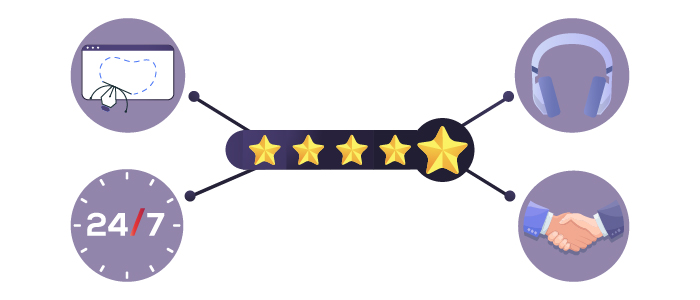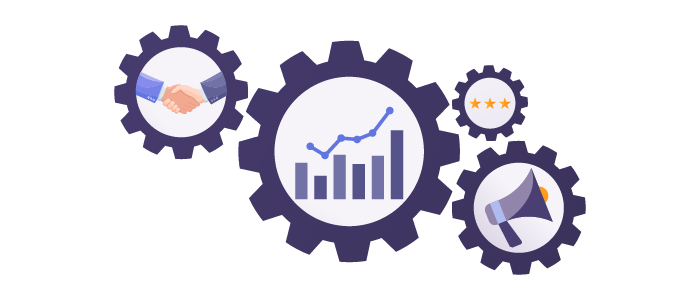What is Customer Service Experience and How to Benefit
Most consumers consider customer service experience a top factor when choosing which companies to support. Improving this process should be a matter of “when” rather than “if” since 68% of consumers have left a brand in the past year due to bad customer service experience.
Consequently, your company’s success depends on how well customers are treated and, more importantly, how they perceive the treatment they are offered. But one thing is certain: customers who fulfill their needs will likely stick around and support your company’s growth. In fact, 89% are more inclined to make another purchase after a favorable customer service experience.
That’s why, if you’re in charge of marketing, paying close attention to the personnel’s attitude toward clients is a key factor in improving the conversion rate.
What is Customer Service Experience?

The term “customer service experience” refers to the overall opinion a buyer gets about a company through its sales support and service staff before, during, and after a purchase. This can include call assistance, email support, self-service support, live chats, and an in-person helpdesk. However, these are only the tip of the iceberg regarding customer care.
And to some extent, a company’s customer service can be more important to its continuing success than any pricing, promotion, or awareness strategy. Under these conditions, it is important to make every effort to emphasize the following aspects of service delivery:
- The friendliness of the team;
- The user-friendliness of the interface;
- Post-service feedback and follow-up;
- The convenience of access to support.
Taking care of your customers may increase brand trust, stronger connections with existing clients, and favorable word of mouth, which can be a powerful differentiator for your brand.
SIDENOTE. Delivering outstanding customer service should be a continuous process, not a one-time event. By showing that you care about the consumer on an emotional level, you can boost your customer service.
Customer Service or Customer Service Experience?
Understanding that customer service and customer service experience are two different concepts is essential. The customer service process is reactive, meaning the clients initiate the communication, and the company’s representatives must focus on guiding and assisting.
Customer service experience, on the other hand, requires proactivity and constant focus on predicting the client’s next step, all to get the best outcome possible. It includes everything from a customer’s initial contact with the organization to long after they’ve made a purchase and back again, as customer interactions with a business are cyclical.
Multiple teams work together to provide a satisfying experience for customers seeking assistance through customer service. The quality of the interaction determines everything.
5 Practices for Better Customer Service Experience

Generally, good customer service is characterized by a mix of the following 5 practices:
1. Personalization
Communicating with your customers on a more individual level is always appreciated, regardless of the size of your business. More people are receptive to humanizing the company as the domain provides more opportunities.
Just think that 93% of consumers are more likely to become repeat buyers after a personalized experience. Customers like dealing with actual people, not faceless corporations.
2. Providing Support on Multiple Channels
Customers who are too busy to call the company’s main number or would like a more flexible method of contact might benefit from the availability of other communication channels. In this regard, staff members should be well-versed in assisting via email, chat, and social media.
But remember, while using the email approach, make it clear to customers that you need at least 24 hours to answer their emails. A consumer with a query or who wants to point out an issue would appreciate a quick answer.
Furthermore, if the consumer does not want to contact the company, try adding a FAQ section to your website or publishing a knowledge article, which can be a great way to keep them engaged in the process.
3. Education and Transparency
Customers may need to be educated about a service or a product. Of course, in this process, there may arise an opportunity for cross-selling and up-selling. Yet, attempting that through underhanded manners and profiting from a customer’s lack of awareness can result in a bad experience.
But more importantly, the representative must be fully aware of the product’s capabilities and features and understand its limitations. There’s nothing more unpleasant than staff members giving faulty advice to send people away and pressuring them to spend additional money for no additional value.
4. Keep a Good Attitude
A good attitude is crucial when trying to provide first-rate services to customers.
Sometimes, an email or a chat session may be misunderstood and seen as unfriendly, especially because the recipient doesn’t get the emotion, body language, and facial expression usually present in a direct conversation.
This is why you should work on the tone and be open to using expressions, idioms, or emoticons to convey a more personal approach.
You may also add a touch of surprise and excitement by remembering and rewarding loyal customers. One way to achieve this is to express gratitude to regular buyers. In that regard, a Customer Relationship Management tool might help you create a more familiar environment.
5. Take the Time to Listen Carefully
Paying attention to consumer feedback entails listening in real-time and reviewing historical data. Assure your clients that their voices are heard, and they will be more satisfied as you take the time to listen and address concerns directly.
Do not make any assumptions about what they are trying to say; instead, show that you are actively listening by restating the issue in your own words when you respond by phone or live chat.
Poor Customer Service Experience in Marketing

A bad customer service experience might hurt a client’s overall perception of a brand. Furthermore, in today’s technologically advanced society, a story about a poor customer service experience may travel worldwide at the speed of light.
Single points of contact, inability to empathize, and ineffective listening all contribute to poor experiences. A UK study by BI Intelligence found that it might take as many as 12 good customer experiences to make up for just one unfavorable incident.
Yet, full automation is not the answer. While companies started using bots for their customer services, statistics say that only one poor chat customer support can drive away approximately 30% of consumers.
The era of speed has also left its imprint on us due to the many electronic forms of communication. People expect businesses to keep up with the times by providing fast customer service and communication.
Nowadays, a 10-minute response time (preferably less) is considered optimal.
How to Align CSE with Your Marketing Strategy

Marketing is often prioritized over customer service, but combining the two keeps customers loyal and satisfied. How well a company identifies itself and interacts with consumers determines its success. Therefore, it is important to align marketing with customer service as it will boost your business’s image; furthermore, these two departments can better identify new opportunities to improve.
If you are skeptical, we’ll explain how a simple conversation may help identify brand and customer service issues before they become complaints. Marketers can also use this information to see whether their content and efforts are reaching the intended audience.
1. Ensure a Consistent Trip for Your Consumers
Customers often see all of your company’s communication channels as a whole, meaning that each is considered synonymous with one another. Email, social media, chatbots, telephone, and other electronic means of communication all fall under this category.
Your customer satisfaction ratings may drop substantially if customers have different channel experiences. Thus, try to provide consistency on all the channels you are using. If you are using multiple platforms, try to answer customer requests on each of them quickly, as this will prove that you are easily accessible everywhere.
2. Establish Genuine Cross-sell and Up-sell Opportunities
Both teams can help you cross-sell and up-sell, leading to increased revenue in the long run.
With today’s technology, marketers can only add new products to a client’s wish list and try to get them to upgrade their plans. However, getting the marketing team to persuade prospects to add one or more products to their carts in real time is hard.
Together, they may increase the likelihood of up-selling and cross-selling by encouraging the marketing team to provide content with a call to action.
Aberdeen Group’s study shows that companies that align their customer service and marketing can significantly increase annual company revenue, save business relationships, stop customers from leaving with high customer win-back rates, build loyalty, and prioritize the customer experience.
3. Give More Importance to the Consumer Persona
In addition, it is essential to devote additional effort to developing consumer personas since it might be challenging to identify your target customers. Even if customer personas are fictitious representations of your target consumers, you may realize over time that you do not understand your customers as well as you thought.
If you merge marketing with customer service, you will learn more about your customers.
Let your marketing team know about your happy customers so they can find more examples of customer success and happiness to use in PR and other customer-focused marketing efforts. And always remember, a business must constantly be looking for new clients but delighting and maintaining the ones it currently has should be one of the top priorities.
Key Takeaways
Phone support, email support, self-service, live chats, a comprehensive knowledge base, and an in-person helpdesk are all components of the customer service experience. Providing exceptional customer service is not a one-time occurrence but an ongoing effort.
It’s important to remember that although customer service is a reactive process, meaning the clients initiate the conversations, the customer service experience is proactive and focuses more on anticipating the client’s next move to get the greatest possible result.
Personalization of the brand for the consumer, assistance across different channels, education and transparency, a positive attitude, and attentiveness to the customer’s needs are all practices that contribute to a positive customer service encounter.
A single instance of poor customer service has the potential to ruin an organization’s marketing efforts completely.
You can coordinate the customer service experience and marketing strategies by ensuring your customer has a consistent trip, giving more importance to your customer persona, and increasing your cross-sell and up-sell opportunities.